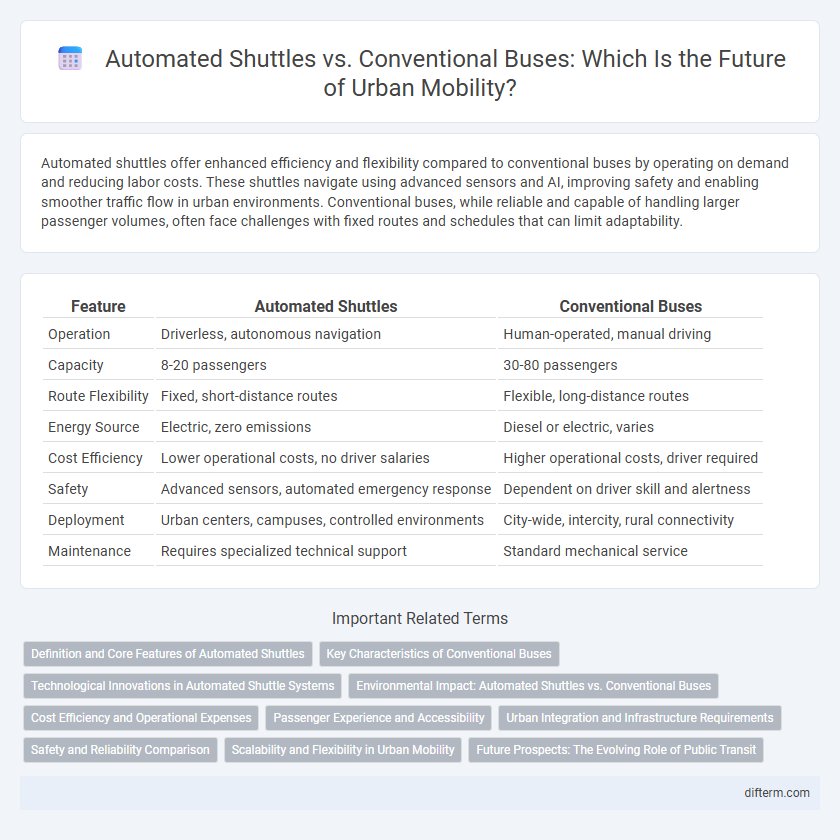Automated shuttles offer enhanced efficiency and flexibility compared to conventional buses by operating on demand and reducing labor costs. These shuttles navigate using advanced sensors and AI, improving safety and enabling smoother traffic flow in urban environments. Conventional buses, while reliable and capable of handling larger passenger volumes, often face challenges with fixed routes and schedules that can limit adaptability.
Table of Comparison
| Feature | Automated Shuttles | Conventional Buses |
|---|---|---|
| Operation | Driverless, autonomous navigation | Human-operated, manual driving |
| Capacity | 8-20 passengers | 30-80 passengers |
| Route Flexibility | Fixed, short-distance routes | Flexible, long-distance routes |
| Energy Source | Electric, zero emissions | Diesel or electric, varies |
| Cost Efficiency | Lower operational costs, no driver salaries | Higher operational costs, driver required |
| Safety | Advanced sensors, automated emergency response | Dependent on driver skill and alertness |
| Deployment | Urban centers, campuses, controlled environments | City-wide, intercity, rural connectivity |
| Maintenance | Requires specialized technical support | Standard mechanical service |
Definition and Core Features of Automated Shuttles
Automated shuttles are driverless, electric vehicles designed to transport passengers on fixed or flexible routes using advanced sensors, GPS, and AI for navigation and safety. Unlike conventional buses operated by human drivers, these shuttles offer precise route control, reduced labor costs, and enhanced energy efficiency through electric propulsion. Core features include autonomous driving capabilities, compact size for urban environments, and real-time monitoring systems that improve operational efficiency and passenger experience.
Key Characteristics of Conventional Buses
Conventional buses rely on human drivers, offering flexibility in route adjustments and real-time decision-making that automated shuttles currently cannot match. Their high passenger capacity and established infrastructure support widespread urban and intercity transit with proven safety and operational standards. Maintenance and operational costs vary but generally benefit from experienced workforce availability and extensive service networks.
Technological Innovations in Automated Shuttle Systems
Automated shuttle systems integrate advanced sensor technologies, including LIDAR, radar, and computer vision, to enhance real-time environment perception and safe navigation. These shuttles utilize sophisticated AI algorithms and machine learning models for dynamic routing and obstacle avoidance, optimizing efficiency and reducing human error. Innovative vehicle-to-everything (V2X) communication enables seamless interaction with infrastructure and other vehicles, improving traffic flow and passenger safety.
Environmental Impact: Automated Shuttles vs. Conventional Buses
Automated shuttles significantly reduce carbon emissions by utilizing electric propulsion and energy-efficient routing, unlike conventional buses that often rely on diesel engines contributing to air pollution. These shuttles minimize noise pollution and decrease urban congestion through optimized passenger loads and real-time traffic data integration. Transitioning to automated electric shuttles supports sustainable urban mobility and aligns with global emission reduction targets.
Cost Efficiency and Operational Expenses
Automated shuttles reduce operational expenses by minimizing labor costs and increasing fuel efficiency compared to conventional buses. Maintenance costs for automated shuttles are often lower due to advanced diagnostics and fewer mechanical components prone to wear. Cost efficiency improves as automated shuttles optimize route management and energy consumption, leading to significant savings over traditional bus operations.
Passenger Experience and Accessibility
Automated shuttles offer enhanced passenger experience through smoother rides and on-demand services, reducing wait times compared to conventional buses. Their smaller size and advanced sensors improve accessibility by navigating complex routes and accommodating mobility devices more efficiently. Conventional buses provide higher capacity but often lack the personalized comfort and flexible scheduling that automated shuttles deliver.
Urban Integration and Infrastructure Requirements
Automated shuttles offer enhanced urban integration by requiring less physical space and adapting more efficiently to existing infrastructure compared to conventional buses, which demand larger road lanes and dedicated bus stops. Their compact size and flexibility allow seamless operation in mixed-traffic conditions and pedestrian zones, reducing the need for extensive road modifications. Conventional buses often necessitate substantial infrastructure investments such as reinforced bus lanes and expanded terminals to accommodate higher passenger volumes and vehicle size.
Safety and Reliability Comparison
Automated shuttles demonstrate enhanced safety features through advanced sensors and real-time obstacle detection, reducing human error risks common in conventional buses. Reliability in automated shuttles is bolstered by consistent performance and predictive maintenance enabled by AI, contrasting with conventional buses' dependence on driver skill and manual upkeep. Studies indicate automated systems achieve lower accident rates and downtime, positioning them as safer and more reliable options in urban mobility.
Scalability and Flexibility in Urban Mobility
Automated shuttles offer superior scalability in urban mobility due to their ability to be deployed in smaller fleets and adjusted in real-time based on demand, enhancing operational efficiency. Conventional buses, constrained by fixed routes and schedules, lack the flexibility to adapt quickly to fluctuating passenger volumes or emerging urban areas. The integration of automated shuttles supports dynamic route optimization, reducing congestion and improving connectivity in rapidly evolving city environments.
Future Prospects: The Evolving Role of Public Transit
Automated shuttles are poised to transform public transit by enhancing last-mile connectivity and reducing operational costs through driverless technology. Conventional buses retain an essential role in high-capacity routes, but integrating automated shuttles can improve overall network efficiency and accessibility. Future public transit systems will likely blend both modes, leveraging automation advances to optimize service frequency, reduce emissions, and meet evolving urban mobility demands.
Automated shuttles vs Conventional buses Infographic

 difterm.com
difterm.com